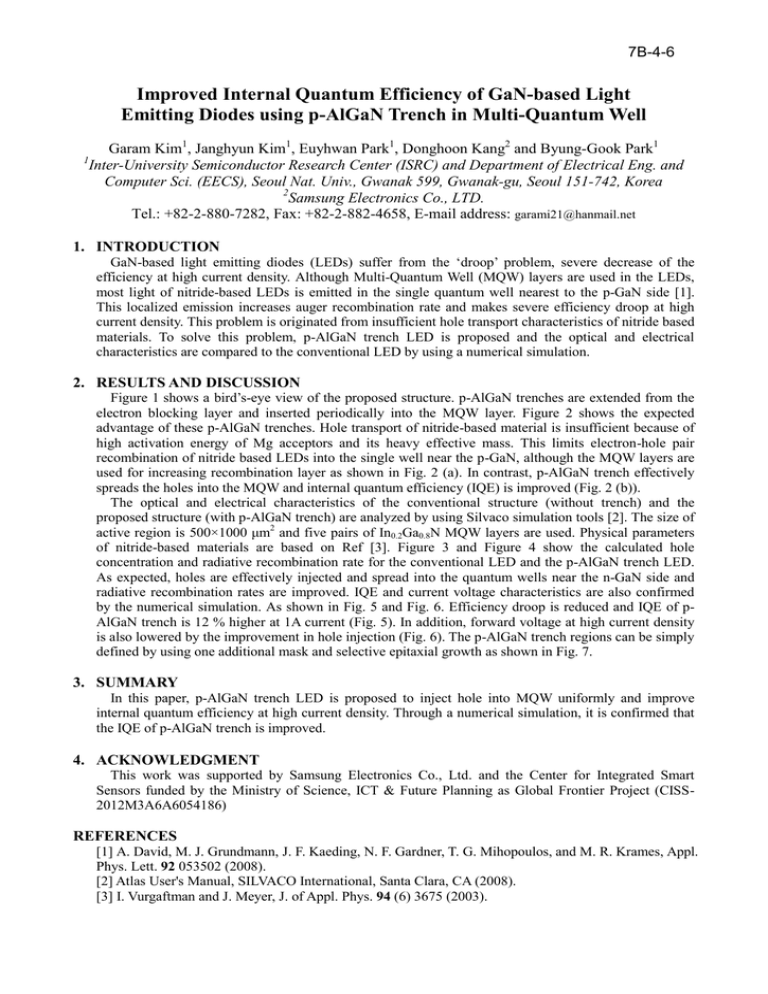Improved Internal Quantum Efficiency of GaN-based Light
advertisement

7B-4-6 Improved Internal Quantum Efficiency of GaN-based Light Emitting Diodes using p-AlGaN Trench in Multi-Quantum Well 1 Garam Kim1, Janghyun Kim1, Euyhwan Park1, Donghoon Kang2 and Byung-Gook Park1 Inter-University Semiconductor Research Center (ISRC) and Department of Electrical Eng. and Computer Sci. (EECS), Seoul Nat. Univ., Gwanak 599, Gwanak-gu, Seoul 151-742, Korea 2 Samsung Electronics Co., LTD. Tel.: +82-2-880-7282, Fax: +82-2-882-4658, E-mail address: garami21@hanmail.net 1. INTRODUCTION GaN-based light emitting diodes (LEDs) suffer from the ‘droop’ problem, severe decrease of the efficiency at high current density. Although Multi-Quantum Well (MQW) layers are used in the LEDs, most light of nitride-based LEDs is emitted in the single quantum well nearest to the p-GaN side [1]. This localized emission increases auger recombination rate and makes severe efficiency droop at high current density. This problem is originated from insufficient hole transport characteristics of nitride based materials. To solve this problem, p-AlGaN trench LED is proposed and the optical and electrical characteristics are compared to the conventional LED by using a numerical simulation. 2. RESULTS AND DISCUSSION Figure 1 shows a bird’s-eye view of the proposed structure. p-AlGaN trenches are extended from the electron blocking layer and inserted periodically into the MQW layer. Figure 2 shows the expected advantage of these p-AlGaN trenches. Hole transport of nitride-based material is insufficient because of high activation energy of Mg acceptors and its heavy effective mass. This limits electron-hole pair recombination of nitride based LEDs into the single well near the p-GaN, although the MQW layers are used for increasing recombination layer as shown in Fig. 2 (a). In contrast, p-AlGaN trench effectively spreads the holes into the MQW and internal quantum efficiency (IQE) is improved (Fig. 2 (b)). The optical and electrical characteristics of the conventional structure (without trench) and the proposed structure (with p-AlGaN trench) are analyzed by using Silvaco simulation tools [2]. The size of active region is 500×1000 μm2 and five pairs of In0.2Ga0.8N MQW layers are used. Physical parameters of nitride-based materials are based on Ref [3]. Figure 3 and Figure 4 show the calculated hole concentration and radiative recombination rate for the conventional LED and the p-AlGaN trench LED. As expected, holes are effectively injected and spread into the quantum wells near the n-GaN side and radiative recombination rates are improved. IQE and current voltage characteristics are also confirmed by the numerical simulation. As shown in Fig. 5 and Fig. 6. Efficiency droop is reduced and IQE of pAlGaN trench is 12 % higher at 1A current (Fig. 5). In addition, forward voltage at high current density is also lowered by the improvement in hole injection (Fig. 6). The p-AlGaN trench regions can be simply defined by using one additional mask and selective epitaxial growth as shown in Fig. 7. 3. SUMMARY In this paper, p-AlGaN trench LED is proposed to inject hole into MQW uniformly and improve internal quantum efficiency at high current density. Through a numerical simulation, it is confirmed that the IQE of p-AlGaN trench is improved. 4. ACKNOWLEDGMENT This work was supported by Samsung Electronics Co., Ltd. and the Center for Integrated Smart Sensors funded by the Ministry of Science, ICT & Future Planning as Global Frontier Project (CISS2012M3A6A6054186) REFERENCES [1] A. David, M. J. Grundmann, J. F. Kaeding, N. F. Gardner, T. G. Mihopoulos, and M. R. Krames, Appl. Phys. Lett. 92 053502 (2008). [2] Atlas User's Manual, SILVACO International, Santa Clara, CA (2008). [3] I. Vurgaftman and J. Meyer, J. of Appl. Phys. 94 (6) 3675 (2003). 7B-4-6 A (a) Fig. 1. A bird’s-eye view of the p-AlGaN trench LED. A’ (b) Fig. 2. Hole distribution in the MQW of the conventional structure and the p-AlGaN trench LED. Fig. 3. Calculated hole concentration at current of 1 A for the conventional LED and the p-AlGaN trench LED. Fig. 4. Calculated radiative recombination rate at current of 1 A for the conventional LED and the pAlGaN trench LED. 72 % 84 % at 1A current Fig. 5. Internal quantum efficiency of the conventional LED and the p-AlGaN trench LED. (a) Oxide mask patterning (b) MQW growth Fig. 6. Current voltage (I-V) characteristics of the conventional LED and the p-AlGaN trench LED. (c) Oxide removal (d) p-AlGaN and p-GaN growth Fig. 7. Fabrication process for the p-AlGaN trench LED. One additional photolithography process is necessary for the formation of the p-AlGaN trench regions.

